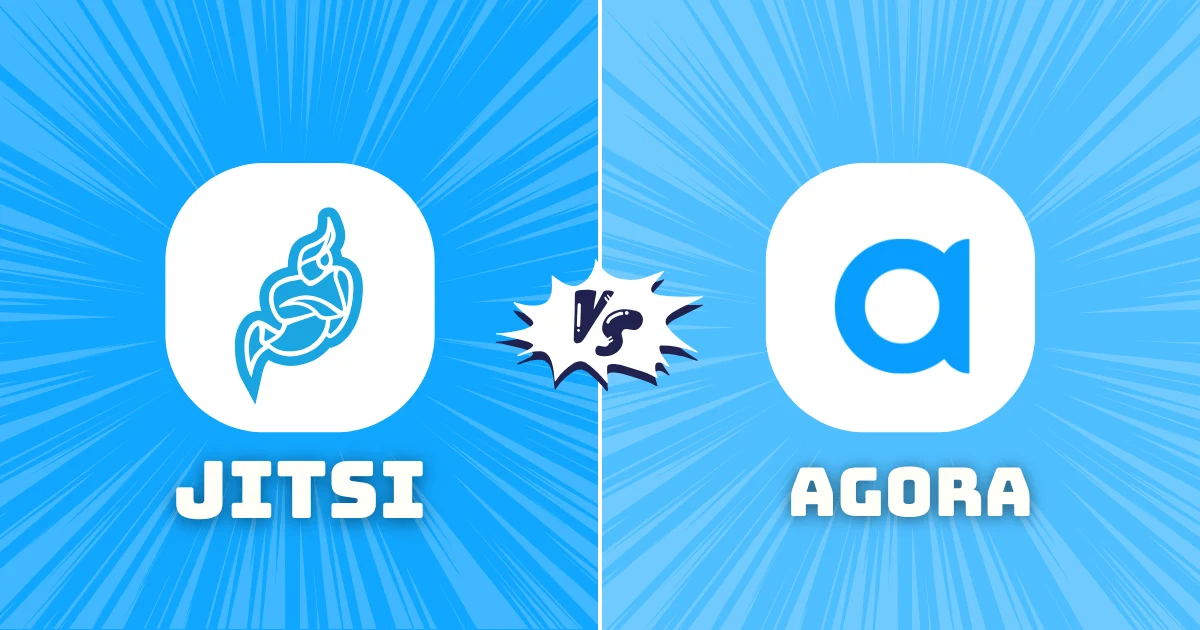Introduction
When you weigh Jitsi vs Agora for embedding live video, the right choice hinges on how much control you need, how many users you expect, and how predictably you must budget. This guide walks you through every factor—from pricing to developer tooling—so you can decide with confidence.
Jitsi vs Agora: Quick Comparison
| Factor | Jitsi (open-source) | Agora (cloud SaaS) |
|---|---|---|
| Cost model | Free to self-host; hosting & DevOps extra | Pay-as-you-go per participant-minute |
| Scalability | Hundreds per call on one server | Millions of concurrent users via global edge network |
| Video quality | Good; may drop under poor networks | High-definition with AI noise suppression & SD-RTN™ routing |
| Architecture | WebRTC SFU (Jitsi Videobridge) | Proprietary SD-RTN™ plus regional media relays |
| Security | End-to-end encryption possible but manual | AES-128/256 in transit, token-based auth, regional data zones |
| Customization | Full code access; unlimited branding | Rich SDK extensions, but closed-source |
| Ideal use cases | Community calls, internal tools, EDU pilots | Large events, telehealth, gaming, IoT |
Why Listen to This Guide
I’ve helped launch e-learning platforms on both open-source video SDKs and commercial clouds. Drawing on that experience—and the latest vendor docs—I’ll break down the trade-offs in plain language, with no jargon or keyword stuffing.
1. Pricing & Total Cost of Ownership
Jitsi
- License cost: $0 (Apache 2.0 license).
- Hosting: You supply servers, bandwidth, and monitoring. A 200-participant SFU at 720p ≈ 8 vCPUs, 2 Gbps egress → ~$120–150/month.
- DevOps overhead: Budget engineer time for updates, scaling, and uptime alerts.
Agora
- Metered pricing: $0.99 per 1,000 audio minutes, $5.99 per 1,000 HD video minutes.
- Add-ons: Recording, RTMP out, whiteboard, analytics charged separately.
- Predictability: Variable; costs spike during high-traffic events.
Bottom line:
- Predictable traffic + in-house DevOps → Jitsi can be cheaper.
- Massive or unpredictable global events → Agora avoids hardware commitments.
2. Video Quality & Network Performance
Jitsi’s SFU Approach
- Uses Jitsi Videobridge (SFU) → relays streams without transcoding.
- Low CPU usage but pushes bandwidth decisions to clients.
- Simulcast helps, but packet loss still affects HD.
Agora’s SD-RTN™
- 200+ global PoPs, least-lossy packet routing.
- AI noise suppression, spatial audio.
- Sub-400 ms latency even on 4G.
Bottom line:
- Local/regional → Jitsi performs well.
- Global/mobile-heavy → Agora has a measurable quality edge.
3. Scalability & Reliability
| Metric | Jitsi | Agora |
|---|---|---|
| Single server capacity | ~500 video feeds w/ simulcast | N/A (cloud elastic) |
| Horizontal scaling | Manual (add JVBs + load balancer) | Automatic |
| Uptime SLA | Your infra dependent | 99.9% available |
| Global failover | DIY multiple regions | Built-in multi-region |
Bottom line:
- Millions of users → Agora simplifies capacity planning.
- SMEs → A 2-node Jitsi cluster is usually enough.
4. Security & Compliance
- Jitsi: DTLS-SRTP by default, optional end-to-end encryption (Chrome only). HIPAA/FINRA needs custom infra & logging.
- Agora: Region-restricted routing, encrypted recordings, signed tokens, SOC 2 & HIPAA ready.
Bottom line:
- Compliance-heavy industries → Agora shortens procurement.
- Privacy-first dev teams → Jitsi gives source code access.
5. Developer Experience
Jitsi SDK
- Languages: JS/TS (React), Android, iOS.
- Customization: Full UI control; fork repo or use
lib-jitsi-meet. - Community: 20k+ GitHub stars, forum support.
Agora SDK
- Languages: JS, React, React Native, Flutter, Unity, Electron, C++, Android, iOS.
- Extensions: Pre-built UI kit, transcription, whiteboard.
- Support: 24/7 tickets, enterprise solution architects.
Learning curve:
- Jitsi → Fast setup (docker-compose), but deep customization = source code dive.
- Agora → Rich docs, but token auth/events take longer to master.
6. Customisation & Branding
- Jitsi: Full branding control (HTML/CSS/JS).
- Agora: App Builder for drag-drop layouts, virtual backgrounds, speaker views.
Bottom line:
- Need white-label fast → Agora UI Kit.
- Need pixel-perfect control → Jitsi.
7. Analytics & Monitoring
| Feature | Jitsi | Agora |
|---|---|---|
| Real-time QoS graphs | Needs Grafana/Prometheus setup | Built-in dashboard (MOS, jitter, delay) |
| Recordings | Local/Jibri-based; manual scaling | Cloud recording per minute (HLS, MP4) |
| Alerting | Custom tooling | Built-in threshold alerts |
8. Best-Fit Use Cases
- SME internal collaboration → Jitsi (keeps data private, no recurring fees).
- Open-source communities → Fork and self-host Jitsi.
- Large virtual events → Agora handles tens of thousands of viewers.
- Telehealth/Fintech → Agora’s compliance + region locking.
- Education pilots → Start on Jitsi, migrate to Agora if scaling worldwide.
9. Migration Considerations
- Jitsi → Agora: Rebuild signaling; refactor auth to token-based joins.
- Agora → Jitsi: Regain source access, but need TURN/STUN setup and may lose global QoS.
Choosing Your Platform
If you need complete control, no license fees, and are comfortable running servers, Jitsi is the pragmatic pick. For global scale, enterprise-grade SLAs, and feature velocity, Agora justifies its usage fees with rock-solid QoS and rich SDKs.
Want help setting up Jitsi or Agora for your organization? Reach out and I’d be happy to guide you.
